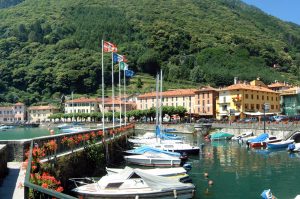
Dongo is a touristic town in an industrial zone situated on the northwestern side of Lake Como. It lies at the mouth of the Albano river, with a breathtaking view of Mount Legnone and the Northern Grigne mountains. One of the oldest traditions in this area is the manufacturing of iron-based products, even though iron mining in the region was discontinued all the way back in 1800!
The origins of Dongo date back to Roman times. In 1534, the town was joined with Grevedona and Sorico, thus becoming one of the most important civil and religious districts of the entire Lake Como area. The only sign remaining of this medieval heritage is Piazza Vertua Gentile. But Dongo’s special place in local history is actually linked to the end of Fascism: it was near here that several leaders of the Fascist party were captured and executed on April 28, 1945, while trying to escape to Switzerland with Benito Mussolini.
Today, Dongo is a peaceful and welcoming town, preserving a number of interesting sites such as, for example, the Palazzo del Vescovo, built in 1600 for the Marquis Cosson, and then purchased in 1854 by the Bishop of Como, Carlo Romano. One century later, the palace became property of the City itself. Thanks to the residents’ efforts, the building has been carefully restored and donated to the School of Music “Alto Lario”, also home to the “International Piano Academy”.
Another interesting site is Palazzo Manzi, located in the Piazza next to the pier. Built in 1824 by Pietro Gilardoni, this building became a symbol of the Napoleonic era in all the Lake Como area. In 1937, Giuseppina Manzi donated the building to the city, to become the City Hall. The rather modest façade hides magnificent interiors, including a large two-level hall with royal balcony. With all its gilding and golden decorations, the hall is called “Sala d’Oro” (Golden Hall). At the center of the vaulted ceiling is a fresco representing the Parnaso, the Muse’s sacred mount, by Giuseppe Lavelli, student of Appiani. Today the Palace is open to the public during morning hours.
Among the many churches in Dongo, especially notable is the Church of Santo Stefano, one of the largest in the area. It is a Romanesque church, rebuilt in 1716 on the grounds of a 1315 temple. The interior is composed of three naves and three apses, with the original baptistry from 1400, 16th century frescoes and original plaster statues of S. Salter from 1700.
Another interesting church is Santa Maria della Martinica, built in the 11th century and renovated in the recent 20th century. The church’s aisles and attic are still decorated with frescoes from 1310, and houses a beautiful silver cross from Sir Gregory’s studio from 1513.
Quite unusual is the church of Madonna delle Lacrime (Lady of the Tears), built on the grounds of an apparently miraculous event. In the early 1500’s, not far from the Albano River, there was a chapel dedicated to the Madonna with the Baby which had remained intact despite a river overflowing. Later, in 1553, so the story goes, the statue of the Madonna actually wept and the local priest named Bonizio collected the tears and shared the miracle with the citizens who then built a small chapel on the site.
Situated between the mountains and the Lake, Dongo also offers a wide variety of sporting activities such as trekking, mountain climbing, paragliding and various water sports. And of course, visitors can also depart from Dongo by boat to explore the many beautiful sites on Lake Como.
